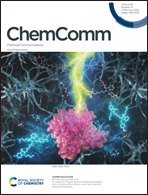Radical selenation of C(sp3)–H bonds to asymmetric selenides and mechanistic study†
Abstract
Selenides are important structural motifs with a broad range of biological activities and versatile transformational abilities. In this study, a novel and mild method was developed for the facile synthesis of asymmetric selenides under metal-free conditions. The key features of this reaction include good functional-group tolerance, the use of readily available reagents and cheap, low-toxicity solvent, and amenability to gram-scale synthesis. The results of preliminary radical-trapping experiments and a kinetic isotope effect study support a radical process.



 Please wait while we load your content...
Please wait while we load your content...